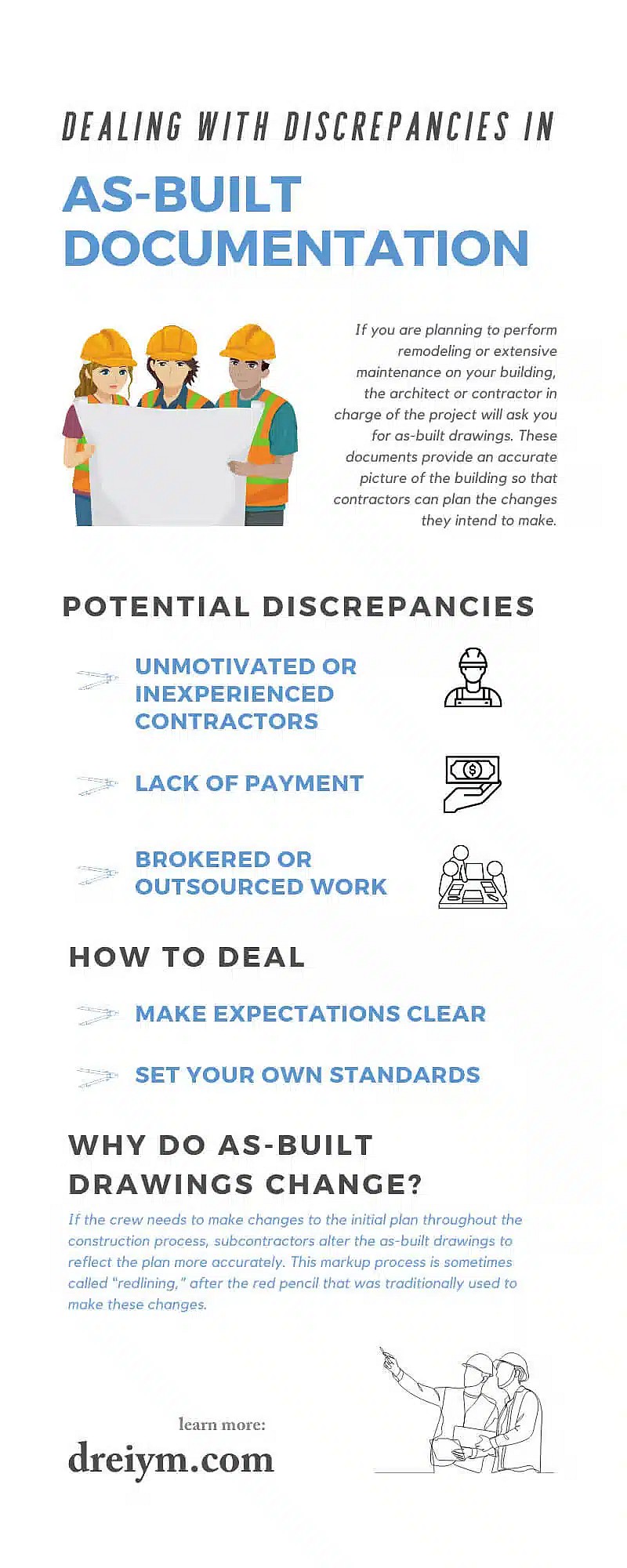Dealing With Discrepancies In As-Built Documentation
If you are planning to perform remodeling or extensive maintenance on your building, the architect or contractor in charge of the project will ask you for as-built drawings. These documents provide an accurate picture of the building so that contractors can plan the changes they intend to make.
However, construction projects are complex and often require additional changes during the process. What do you do when there are discrepancies in as-built documentation due to last-minute changes or errors in record-keeping? Dreiym Engineering’s guide will show you how to deal with inaccurate information in as-built drawings.
What Is an As-Built Drawing?
As-built drawings are blueprints or detailed drawings that document the existing layout of a building to scale. This set of drawings includes floor plans, reflected ceiling plans, cross-sections of individual rooms, and other clearly marked illustrations that depict the various systems in the building.
General building contractors are usually tasked with creating these drawings during the initial construction process. In the past, contractors drew these with pencils, ink, and paper, but today they use computer-aided design (CAD) or building information modeling (BIM) software.
Why Do As-Built Drawings Change?
If the crew needs to make changes to the initial plan throughout the construction process, subcontractors alter the as-built drawings to reflect the plan more accurately. This markup process is sometimes called “redlining,” after the red pencil that was traditionally used to make these changes.
Once those markups are finished, the general contractor transfers the changes to a fresh new set of working drawings. Some people in the construction industry use the terms “as-built drawings” and “redline drawings” interchangeably; at this point in the process, they serve the same purpose.
Purposes of As-Built Drawings
As-built documentation serves a variety of needs throughout the life span of a building.
Complete Record of Changes
Every time someone marks up an as-built drawing, they add those changes to the documentation so the construction crew has up-to-date drawings. These documents serve as a record of work performed and a plan of what the crew was directed to do.
Attestation of Work Performed
When construction is finished, as-built drawings certify that the contractor and their crew performed all the work documented. If the owner wants to remodel or perform maintenance after construction, the as-built drawings will show contractors a detailed layout of the building’s hidden features. If the owner enlists an electrical engineer to perform a site walk-down inspection, that engineer will ask to see the as-built drawings to get an accurate picture of the building.
Demolition Drawings
If the building is slated for partial or total demolition, as-built drawings will be invaluable to the demolition crew. The owner can even point out which parts of the building to demolish and which to leave intact.
Land Use History
As-built drawings will often pass from one landowner to the next to show the new owner how the previous owner used and built upon the land. If someone discovers an unforeseen object during the building’s initial construction, the as-builts will reflect it.
Potential Discrepancies In As-Built Documentation
Now that we’ve discussed the purpose of as-built drawings and how they’re created, what problems might you run into when dealing with this documentation?
Unmotivated or Inexperienced Contractors
Producing a set of accurate as-built drawings requires a great deal of coordination and attention to detail on the part of the contractor and their crew. However, there are plenty of other tasks to be done on a worksite, and responsibility for as-builts may fall on the most junior contractor. The general contractor may not be motivated to give thorough instructions—or any instructions at all beyond “Here are the specifications; just draw them up.”
The subcontractor or intern given responsibility for the as-built drawings may not have the experience necessary to create thorough and detailed records of the construction. With so many parties and moving parts involved in a building project, extensive documentation may fall by the wayside.
Lack of Payment
Collecting information about the building layout and meticulously updating as-built drawings to reflect changes takes time and effort, both of which cost money. Often, general contractors and foremen in charge of worksites view as-built documentation as an ancillary task. They don’t give it much thought because they are not paid specifically for that task, so getting it done quickly allows them to move on.
Building owners can combat this attitude by periodically asking to see the as-built drawings and inquiring about any changes made. When contractors know that the person in charge of paying them will check their work, they’ll put more effort into documenting changes and updating drawings.
Brokered or Outsourced Work
Because general contractors are in charge of so many different working parts on a construction project, they cannot give 100 percent effort to every aspect. Often, contractors will broker parts of their projects to offsite firms to lighten the load on their onsite crew.
However, inaccuracies are bound to occur when somebody who has never visited the site completes the as-built drawings. The person in charge of creating and updating those drawings may not be privy to last-minute changes or structural concerns on the site.
How To Deal With As-Built Documentation Discrepancies
If you encounter discrepancies between your as-built drawings and the actual structure of your building, contact your contractor and go over each discrepancy. Then, have an experienced subcontractor or crew member update the as-built drawings accurately.
Make Expectations Clear
Stay in contact with your contractor and their crew, and remind them what you expect out of your as-built documentation. All updates to floor plans and diagrams should be clearly marked. If extensive changes must be made, have the person in charge of the as-builts create a clean, new set of drawings.
Set Your Own Standards
In the construction industry, most professionals learn the ins and outs of creating as-built drawings through word of mouth. Contractors and their crews get used to drawing and updating as-built documents via trial and error.
Create your own standards for your construction crew to follow. Examples of helpful standards and guidelines include:
- Meeting with the crew monthly or bimonthly to review updated as-built drawings
- Keeping as-built drawing sheets streamlined without excessive notes in the margins
- Creating new drawings when the old ones undergo a certain number of changes
If you are a building owner looking at your as-built documentation, you may be unhappy when you encounter discrepancies in those drawings. How can you deal with those errors and prevent similar mistakes from occurring again? Stay in contact with the contractors responsible for those drawings, and make your standards and expectations clear.
Do you require the services of a consulting engineer to perform a site walk-down inspection and review as-built documentation with you? Dreiym Engineering’s team of experienced engineers knows how to read as-built drawings and help you identify any inconsistencies.













































